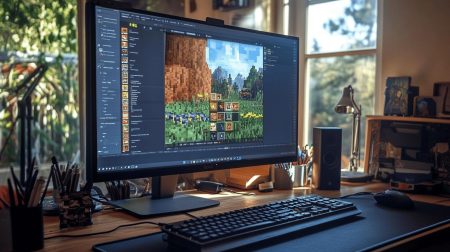How to Safely Remove a Graphics Card from Your Motherboard
To remove a GPU from a motherboard, power off your computer and unplug it. Open the case and locate the GPU, which is usually inserted into a PCIe slot. Gently press down on the release latch and carefully pull out the GPU.
As an experienced gaming PC builder, I cannot stress the importance of safely removing a graphics card from your motherboard. Proper procedures are essential to prevent any damage to the graphics card and the motherboard itself.
Incorrect removal can have serious repercussions, potentially resulting in bent or broken pins on the graphics card, rendering it completely unusable. Furthermore, mishandling during removal can cause harm to the delicate components on your motherboard, such as capacitors or resistors.
To ensure a seamless and secure removal process, it’s crucial to take all necessary precautions and meticulously follow step-by-step instructions. Doing so will safeguard your valuable hardware investment and avoid unnecessary expenses for repairs or replacements.
First of all, what Is a GPU?
Before you learn how to remove a GPU, it is only proper that you have an adequate understanding of what it is.
GPU stands for Graphics Processing Unit. It is a chip responsible for all the image and graphics rendering in an electronic device. It gives you those 2D and 3D resolutions you see on your screen.
Beyond image rendering, a GPU is important for gaming and video editing. Higher-performing GPUs tend to keep up with improved display technologies like 4K and refresh rates.
The GPU is a unit within the graphics card. It combines all the processes that lead to image and video rendering.
The storage capacity of a GPU is in gigabytes (GB). The memory of a GPU is called a VRAM. A higher VRAM would mean a better image display and a faster gaming experience.
We will interchangeably use ‘GPU’ and ‘graphics card’ for this article.
Preparing for Removal
Before you begin the removal process, preparing your computer and yourself properly is important. Following these steps will minimize any potential risks associated with static electricity or accidental power surges.
- Ensure Safety Measures
- Please turn off your computer and unplug it from the power source.
- Ground yourself by touching a metal object, such as your computer case, to discharge any static electricity.
- Gather all necessary tools, including a screwdriver and an anti-static wrist strap if available.
Step-by-Step Guide to Safely Remove Your Graphics Card
Now that you’re prepared let’s walk through the process of safely removing your graphics card from your motherboard.
- Locate the Graphics Card. Ensure your computer is turned off and unplugged. Open your computer case and locate the graphics card on your motherboard, usually positioned in one of the PCI-E slots.
- Remove the Screws Most modern GPUs are secured to the case using screws or brackets. Use a screwdriver to carefully loosen these screws while holding onto any nearby components for stability.
- Unplug the Graphics Card. Once all screws are removed, gently grasp both ends of your GPU and pull it straight out from its slot on the motherboard. Be cautious not to apply excessive force or bend any connectors during this process.
- Handle the Graphics Card Safely After removing the GPU, place it on an anti-static surface, such as an anti-static mat or foam pad, to prevent electrostatic discharge (ESD) damage. Avoid touching sensitive components like circuitry or gold contacts with bare hands; hold it by its edges.
Post-Removal Checklist
Once you have safely removed your graphics card from the motherboard, performing a post-removal checklist is important to ensure everything is in perfect order. Here are the key points to consider:
- Check for Visible Damage Inspect the motherboard and the removed GPU for any signs of physical damage, such as bent pins or broken connectors. If you notice anything out of the ordinary, consult with a professional before proceeding.
- Store the Graphics Card If you’re not replacing your graphics card immediately, store it properly to protect against electrostatic discharge. Please place it in an anti-static bag, wrap it in anti-static material, and store it safely.
- Reassemble Your Computer If you’re not installing a new graphics card immediately, ensure all components are reassembled correctly before powering on your computer again. Double-check that all cables are securely connected, and screws are tightened appropriately.
Choosing the Right Service Provider for Graphics Card Removal
If you’re not confident in your own abilities or don’t have the time, choosing a service provider for graphics card removal can be a great option. Here are some tips to help you make the right choice:
- Research the service provider to ensure they are well-trusted and recognized as an authority.
- Avoid providers that mass-produce or outsource their services, as individual attention and care may be lacking.
- Look for providers that offer insightful analysis and interesting information beyond the obvious.
By selecting the right service provider, you can have peace of mind knowing that professionals will safely remove your graphics card.
Preparing for Your Appointment with the Service Provider
If you’ve decided to seek professional help for graphics card removal, there are a few things you should do before your appointment to ensure a smooth experience:
- Provide Information Gather all relevant information about your computer and graphics card to share with the service provider. This includes make and model details, specific issues you’ve been experiencing, and other relevant information that may help them better understand your needs.
- Prepare Your Computer Back up any important files or data on your computer before being serviced. This will protect against any potential accidents during the removal or installation process.
- Know What to Expect When you arrive at the service provider’s location, they will likely ask you questions about the issues you’ve been facing or the required services. They may also perform diagnostic tests if necessary. Feel free to ask questions and voice any concerns you may have.
These steps ensure a successful appointment with the service provider and a smooth graphics card removal process.
Final Thoughts on Graphics Card Removal
Removing a graphics card from your motherboard requires careful attention and adherence to proper procedures. By understanding the importance of safe removal and preparing adequately beforehand, you can avoid damaging your graphics card and motherboard.
Throughout this guide, we’ve provided step-by-step instructions on safely removing a graphics card while minimizing static electricity risks. We’ve also discussed essential considerations such as checking for visible damage after removal and storing the removed GPU safely if not immediately replacing it.
Lastly, we touched on the significance of choosing the right service provider for graphic card removal and provided tips on preparing for your appointment with them.
By following these guidelines and seeking professional help when needed, you can confidently remove your graphics card without causing any harm. Safety should always be the top priority when working with computer hardware!














